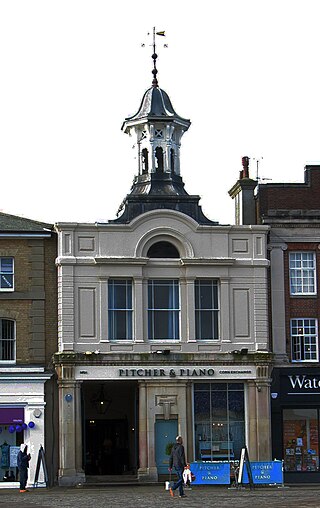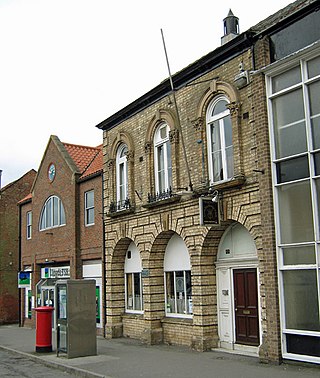
North Hertfordshire is one of ten local government districts in the county of Hertfordshire, England. Its council is based in Letchworth. The district borders East Hertfordshire, Stevenage, Welwyn Hatfield, St Albans, Central Bedfordshire, Luton, and South Cambridgeshire.

The Corn Exchange is an events and concert venue located on Wheeler Street in Cambridge, Cambridgeshire, England. The structure, which was commissioned as a corn exchange, is a Grade II listed building.

The Corn Exchange is an events and concert venue located on St Paul's Square in the Castle area of Bedford, Bedfordshire, England. The structure, which was commissioned as a corn exchange, is a Grade II listed building.

Leicester Corn Exchange is a commercial building in the Market Place in Leicester, Leicestershire, England. The structure, which currently operates as a public house, is a grade II* listed building.

The Corn Exchange is a commercial building on The Payment in St Ives, Cambridgeshire, England. The structure, which is currently used as an events venue, is a Grade II listed building.

Corn exchanges are distinct buildings which were originally created as a venue for corn merchants to meet and arrange pricing with farmers for the sale of wheat, barley, and other corn crops. The word "corn" in British English denotes all cereal grains, such as wheat and barley. With the repeal of the Corn Laws in 1846, a large number of corn exchanges were built in England, particularly in the corn-growing areas of Eastern England.

The Corn Exchange is a commercial building on Fore Street in Hertford, Hertfordshire, England. The structure, which is currently used as an events venue, is a Grade II listed building.

The Corn Exchange is a commercial building in the Saturday Market, Beverley, East Riding of Yorkshire, England. The structure, which was commissioned as a corn exchange and is now used as a department store, is a Grade II listed building.

The Corn Exchange is a retail building in the Market Place, St Albans, Hertfordshire, England. The structure, which is now used to accommodate a pair of shops, is a locally listed building.

The Corn Exchange is a commercial building in Withersfield Road in Haverhill, Suffolk, England. The structure, which is currently vacant and deteriorating, is a Grade II listed building.

The Corn Exchange is a commercial building in the Market Place in Hitchin, Hertfordshire, England. The structure, which is currently used as a bar and restaurant, is a Grade II listed building.

The Corn Exchange is a commercial building in The Pantiles, Royal Tunbridge Wells, Kent, England. The structure, which is currently used as an antiques and fine art market, is a Grade II listed building.

The Corn Exchange is a commercial building in the Market Place, Fakenham, Norfolk, England. The structure, which is currently used as a cinema, is a Grade II listed building.

The Corn Hall is a commercial building in the Market Place, Swaffham, Norfolk, England. The structure, which is used as offices and as a coffee house, is a Grade II listed building.

The Corn Exchange is a commercial building in the Market Place, Kettering, Northamptonshire, England. The structure, which was used as a cinema for much of the 20th century, currently accommodates a restaurant.

The Corn Exchange is a commercial building in the Market Place in Barton-upon-Humber, Lincolnshire, England. The structure, which is now used as a private members club, is a Grade II listed building.

The Corn Exchange, also known as the Women's Institute Hall, is a commercial building in West Street in Rochford, Essex, England. The structure, which is now used by the local branch of the Women's Institute, is a Grade II listed building.

The Corn Exchange is a commercial building in Nottingham Street in Melton Mowbray, Leicestershire, England. The structure, which is now used to provide access to a shopping centre, is a Grade II listed building.

The Corn Exchange is a commercial building in Exchange Square in Beccles, Suffolk, England. The structure, which is now used as a branch of Lloyds Bank, is a Grade II listed building.

The Corn Exchange is a commercial building in the Market Place in Hadleigh, Suffolk, England. The structure, which currently accommodates a small business centre, is a Grade II listed building.





















